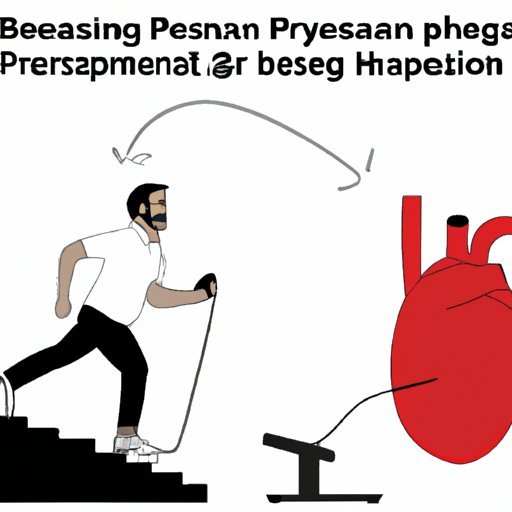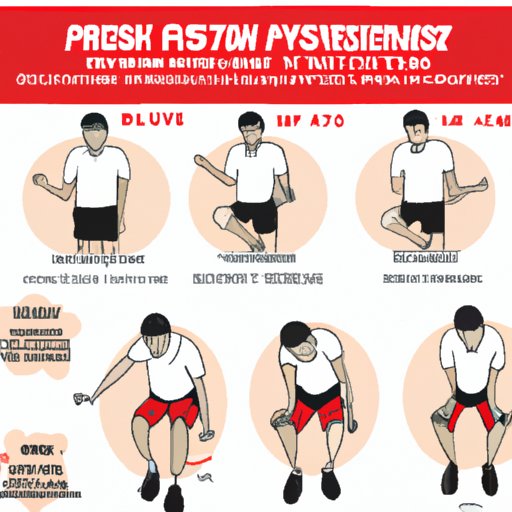Introduction
Blood pressure is a measure of the force with which the heart pumps blood around the body. It is expressed as two numbers – systolic (the top number) and diastolic (the bottom number). High blood pressure, or hypertension, is a major risk factor for heart attack, stroke, and other health complications. For this reason, it is important to understand how exercise can help to control high blood pressure.
The purpose of this article is to explore the benefits of exercise for controlling high blood pressure. We will examine how regular exercise helps to lower blood pressure, the relationship between exercise and blood pressure, and the different types of exercise that can be used to reduce high blood pressure. We will also investigate the short-term and long-term effects of exercise on blood pressure and look at research that has been conducted on the subject. Finally, we will assess the usefulness of exercise for controlling blood pressure and make recommendations for further research.

Examining the Benefits of Exercise on Blood Pressure
Regular physical activity can help to lower blood pressure. Studies have shown that just 30 minutes of moderate aerobic exercise three times a week can significantly reduce both systolic and diastolic blood pressure. Aerobic exercise such as walking, jogging, cycling, swimming, and dancing are all effective ways of reducing blood pressure.
The relationship between exercise and blood pressure goes beyond just lowering the amount of pressure in the arteries. Regular physical activity can improve the strength of the heart muscle, increase the efficiency of the cardiovascular system, and reduce the levels of stress hormones in the body. All of these factors play an important role in controlling blood pressure.
Different types of exercise can be used to lower blood pressure. Aerobic exercise is the most effective form of exercise for reducing blood pressure, but strength training and flexibility exercises can also have a positive effect. Combining different types of exercise into a regular program is the best way to ensure that blood pressure stays within a healthy range.
Investigating the Effects of Exercise on Blood Pressure
The effects of exercise on blood pressure can be divided into two categories: short-term and long-term. In the short term, exercise can cause a temporary increase in blood pressure, but over time, regular exercise leads to a decrease in both systolic and diastolic blood pressure.
Long-term effects of exercise on blood pressure depend on the intensity and duration of the exercise. Studies have shown that people who engage in moderate-intensity physical activity for at least 30 minutes per day have a lower risk of developing high blood pressure than those who do not exercise regularly. Additionally, research has found that people who participate in regular exercise programs have lower systolic and diastolic blood pressure readings than those who do not exercise.
There is a growing body of research that shows the positive effects of exercise on blood pressure. One study examined the impact of aerobic exercise on blood pressure in middle-aged adults and found that those who engaged in regular aerobic exercise had lower resting blood pressure than those who did not exercise. Another study looked at the effects of resistance training on blood pressure in hypertensive patients and found that those who participated in a 12-week program of resistance training had significant decreases in both systolic and diastolic blood pressure.

Exploring How Exercise Reduces High Blood Pressure
There are several different types of exercise that can help reduce high blood pressure. Aerobic exercise, such as walking, jogging, swimming, and cycling, is particularly effective for reducing blood pressure. Strength training, such as weightlifting, can also be beneficial for lowering blood pressure. Flexibility exercises, such as yoga and tai chi, can also help to reduce blood pressure by improving circulation and reducing stress levels.
Diet plays an important role in controlling blood pressure. Eating a diet low in saturated fat, cholesterol, and sodium can help to reduce blood pressure. A diet that is rich in fruits, vegetables, whole grains, and low-fat dairy products can help to keep blood pressure levels in check.
Stress reduction is another important factor in controlling blood pressure. Regular exercise can help to reduce stress levels, which can in turn help to lower blood pressure. Relaxation techniques such as deep breathing, meditation, and yoga can also be effective for reducing stress and lowering blood pressure.
Comparing Different Types of Exercise for Reducing Blood Pressure
Aerobic exercise is the most effective type of exercise for lowering blood pressure. This includes activities such as walking, running, swimming, and cycling. These activities help to reduce blood pressure by increasing the heart rate and improving circulation. They also help to reduce stress levels, which can in turn help to lower blood pressure.
Strength training can also be effective for reducing blood pressure. Weightlifting or resistance training can help to strengthen the heart muscle, improve circulation, and reduce stress levels. Additionally, strength training can help to build muscle mass, which can help to reduce the amount of strain on the heart.
Flexibility exercises, such as yoga and tai chi, can also be beneficial for reducing blood pressure. These exercises help to improve circulation and reduce stress levels. They can also help to increase the range of motion in the joints, which can help to reduce the risk of injury.
Understanding the Impact of Exercise on Lowering Blood Pressure
Adopting a healthy lifestyle is essential for controlling high blood pressure. Eating a balanced diet, getting regular exercise, managing stress levels, and avoiding smoking and excessive alcohol consumption can all help to reduce blood pressure. Regular monitoring of blood pressure is also important for ensuring that it stays within a healthy range.
Making exercise part of a daily routine is the best way to ensure that blood pressure remains within a healthy range. Aim for 30 minutes of moderate aerobic exercise three times a week, as well as strength-training and flexibility exercises. Start slowly and gradually increase the intensity and duration of the exercise as you become more fit. Setting realistic goals and seeking advice from medical professionals can also help to ensure that your exercise program is effective.

Analyzing the Relationship Between Exercise and Blood Pressure
Exercise can have both physiological and psychological effects on blood pressure. Physiologically, exercise can strengthen the heart muscle, increase the efficiency of the cardiovascular system, and reduce the levels of stress hormones in the body. Psychologically, exercise can help to reduce stress levels and improve mood, which can in turn lead to lower blood pressure.
Exercise can also have social effects on blood pressure. Social support can be beneficial for reducing stress levels and improving overall health, both of which can help to lower blood pressure. Additionally, exercising with friends and family can help to create a sense of community and camaraderie, which can be beneficial for mental and emotional wellbeing.

Assessing the Usefulness of Exercise for Controlling Blood Pressure
Exercise can be an effective tool for controlling high blood pressure. Regular physical activity can help to strengthen the heart muscle, improve circulation, and reduce stress levels. Additionally, it can help to reduce the risk of developing high blood pressure in the future.
It is important to set realistic goals when trying to lower blood pressure with exercise. Begin slowly and gradually increase the intensity and duration of the exercise as you become more fit. It is also important to seek advice from medical professionals to ensure that your exercise program is appropriate for your individual needs.
Finally, it is important to remember that exercise is just one part of a healthy lifestyle. Eating a balanced diet, managing stress levels, and avoiding smoking and excessive alcohol consumption can all help to reduce blood pressure. Monitoring blood pressure regularly is also important for ensuring that it stays within a healthy range.
Conclusion
In conclusion, exercise can be an effective tool for controlling high blood pressure. Regular physical activity can help to strengthen the heart muscle, improve circulation, and reduce stress levels. Different types of exercise, such as aerobic, strength, and flexibility exercises, can all be beneficial for lowering blood pressure. Additionally, adopting a healthy lifestyle, including eating a balanced diet, managing stress levels, and avoiding smoking and excessive alcohol consumption, can help to reduce blood pressure.
It is important to set realistic goals when trying to lower blood pressure with exercise. Seek advice from medical professionals to ensure that your exercise program is appropriate for your individual needs. Finally, remember to monitor your blood pressure regularly to ensure that it stays within a healthy range.
(Note: Is this article not meeting your expectations? Do you have knowledge or insights to share? Unlock new opportunities and expand your reach by joining our authors team. Click Registration to join us and share your expertise with our readers.)
